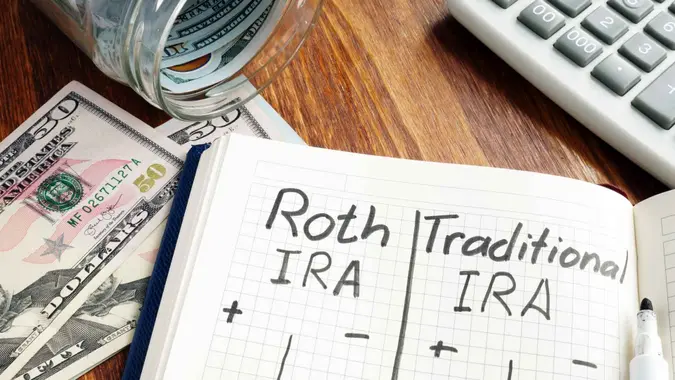Can You Contribute To a Roth Ira After Retirement?

Commitment to Our Readers
GOBankingRates' editorial team is committed to bringing you unbiased reviews and information. We use data-driven methodologies to evaluate financial products and services - our reviews and ratings are not influenced by advertisers. You can read more about our editorial guidelines and our products and services review methodology.

20 Years
Helping You Live Richer

Reviewed
by Experts

Trusted by
Millions of Readers
Contributing to a Roth IRA doesn’t have to stop once you retire. Unlike traditional IRAs, which cap contributions once you reach a certain age, Roth IRAs allow you to keep adding money as long as you have earned income. That means retirees who still work part-time, freelance, or run a business can continue funding their account and growing tax-free savings.
If your only income comes from Social Security, pensions, or investments, however, you won’t be eligible to make new contributions. Knowing these rules can help you decide whether contributing to a Roth IRA after retirement is possible — and whether it makes sense for your financial plan.
What Is a Roth IRA and How Does It Work?
A Roth IRA is a retirement account that offers valuable tax advantages. Unlike a traditional IRA, contributions are made with after-tax dollars — money you’ve already paid taxes on. The trade-off is that your investments can grow tax-free, and qualified withdrawals in retirement aren’t taxed. For many savers, a Roth IRA is an appealing way to build long-term wealth and even support estate planning goals.
In retirement, you can take out the money you contributed — your principal — at any time without penalty. The earnings on those contributions become available tax- and penalty-free once you’re at least 59½ and have had the Roth IRA for five years or more.
Roth IRAs come with annual contribution limits and income restrictions, so not everyone can contribute directly. It’s important to check the IRS rules each year before deciding how much to invest. While you can withdraw your contributions at any time without penalty, it’s best to think of a Roth IRA as a long-term growth tool and avoid dipping in early unless absolutely necessary.
Can a Retired Person Contribute to a Roth IRA?
You can still contribute to a Roth IRA in retirement if:
- You earn income from a job, freelance work, or self-employment.
- Your contribution doesn’t exceed the smaller of your earned income or the annual IRS limit. For 2025, the limit is $7,000, with an additional $1,000 “catch-up” contribution available if you’re age 50 or older.
Good to Know: Social Security and Investment Income Don’t Count
Only money you actively earn — like wages, freelance pay, or self-employment income — counts toward Roth IRA contributions. Income from Social Security, pensions, dividends, or rental properties doesn’t qualify.
Roth IRA Contribution Limits for Retirees in 2025
Your ability to contribute to a Roth IRA depends on your Modified Adjusted Gross Income (MAGI) and your tax filing status. MAGI is your adjusted gross income (AGI) with certain deductions and exclusions added back in, such as student loan interest, tuition, or foreign income. The IRS uses MAGI to decide whether you can make the full contribution, a reduced one, or none at all.
The table below shows the 2025 MAGI limits and contribution rules by filing status.
| Status | 2025 Modified Adjusted Gross Income (MAGI) | Contribution Limit |
|---|---|---|
| Married Filing Jointly or Qualifying Widow(er) | Less than $236,000 | $7,000 $8,000 if you’re 50 or older |
| $236,000 to $246,000 | Reduced contribution limit | |
| More than $246,000 | None | |
| Single, head of household, or married filing separately (and you didn’t live with your spouse at any time during the calendar year) | Less than $150,000 | $7,000 $8,000 if you’re 50 or older |
| $150,000 to $165,000 | Reduced contribution limit | |
| More than $165,000 | None | |
| Married filing separately (if you lived with your spouse at any time during the calendar year) | Less than $10,000 | Reduced |
| More than $10,000 | None |
How a Roth IRA Works in Retirement
A Roth IRA continues to offer valuable benefits even after you retire. Unlike a 401(k) or traditional IRA, you’re not required to take required minimum distributions (RMDs), which means your money can keep growing tax-free for as long as you’d like.
Withdrawals are straightforward: as long as you’re at least 59½ and your Roth IRA has been open for five years or more, you can take out both your contributions and investment earnings completely tax-free.
And if you’re still working in retirement — whether part-time, freelance, or self-employed — you can even continue making contributions, provided you stay within the IRS income and contribution limits.
How to Contribute to a Roth IRA
- You need earned income. Contributions must come from wages, freelance work, or self-employment income — not from Social Security, pensions, or investment income.
- There’s no age cutoff. Even past age 70, you can keep contributing as long as you meet the income requirements.
- Know your limits. You can contribute the smaller of your earned income or the annual IRS limit. For 2025, that’s $7,000 — or $8,000 if you’re 50 or older thanks to the catch-up contribution.
- Watch your MAGI. Income limits apply, so check the Modified Adjusted Gross Income (MAGI) thresholds each year to avoid over contributing.
Keep Growing, But Don’t Overdo It
A Roth IRA can keep working for you in retirement, but you’ll need eligible earned income to keep contributing. Be sure to track your yearly contributions carefully so you don’t go over the IRS limits.
Roth IRA Contribution Rules After Age 70
The SECURE Act eliminated the age cap for Roth IRA contributions, which means you can keep funding your account no matter your age. For retirees who are still working, consulting, or freelancing, this change opens the door to continue building wealth well into retirement. Contributing later in life can give your money more time to grow tax-free and provide added flexibility for estate planning, since Roth IRAs don’t have required minimum distributions (RMDs) during the owner’s lifetime.
The key rule is that you must have earned income to qualify. Wages, self-employment earnings, and other compensation count, but money from pensions, Social Security, or investment income does not. Keeping this distinction in mind ensures you stay eligible and avoid mistakes when adding funds to your account.
Roth IRA vs. Traditional IRA After Retirement
If you’re comparing retirement account options, here’s how Roth IRAs and traditional IRAs stack up once you’re retired:
| Feature | Roth IRA | Traditional IRA |
|---|---|---|
| Tax on withdrawal | No (if qualified withdrawals) | Yes – taxed as ordinary income |
| Contribution age limit | None, but must be earned income | None, but must be earned income |
| RMDs | None | At age 73 |
| Best for | Tax-free growth | Reducing current taxable income |
Should Retirees Still Contribute to a Roth IRA?
If you’re retired but still earning income, keeping up your Roth IRA contributions is a smart way to let your money keep growing tax-free. Your money will grow tax free, and you’re not required to take RMDs. Retirees who are eligible to contribute to a Roth IRA are poised to take advantage of long-term planning.
If you’re contributing to your Roth IRA after age 70, make sure to check contribution limits and whether you fall below the IRS threshold for MAGI. Talk to a financial advisor if you’re unsure about how the rules work.
FAQ
- Can you put money in a Roth IRA if you’re fully retired?
- Yes, but only if you still have earned income. That could come from part-time work, freelance projects, or self-employment. Without earned income, you won’t be eligible to make new contributions.
- What if your only income is Social Security or a pension?
- Unfortunately, that doesn’t count. Social Security benefits, pensions, dividends, and rental income aren’t considered “earned income” by the IRS, so you can’t use them to make Roth IRA contributions. You’ll need wages or self-employment income to qualify.
- Can you contribute if you’re over 70?
- Absolutely. The SECURE Act removed the age limit on Roth IRA contributions, so you can keep adding money no matter how old you are — as long as you meet the income requirements.
- How much can you contribute if you earn less than the annual limit?
- Your contribution is capped at the lesser of your earned income or the annual limit. For example, if you earn $5,000 from part-time work in 2025, that’s the most you can contribute, even though the full limit is $7,000 (or $8,000 if you’re 50 or older).
- How do you make a Roth IRA contribution after retirement?
- The process is the same as contributing before retirement: you’ll need earned income and your modified adjusted gross income (MAGI) must be under the IRS threshold for your filing status. Contributions can be made through payroll deductions, direct transfers, or by setting up regular deposits with your Roth IRA provider.
 Written by
Written by  Edited by
Edited by 

























